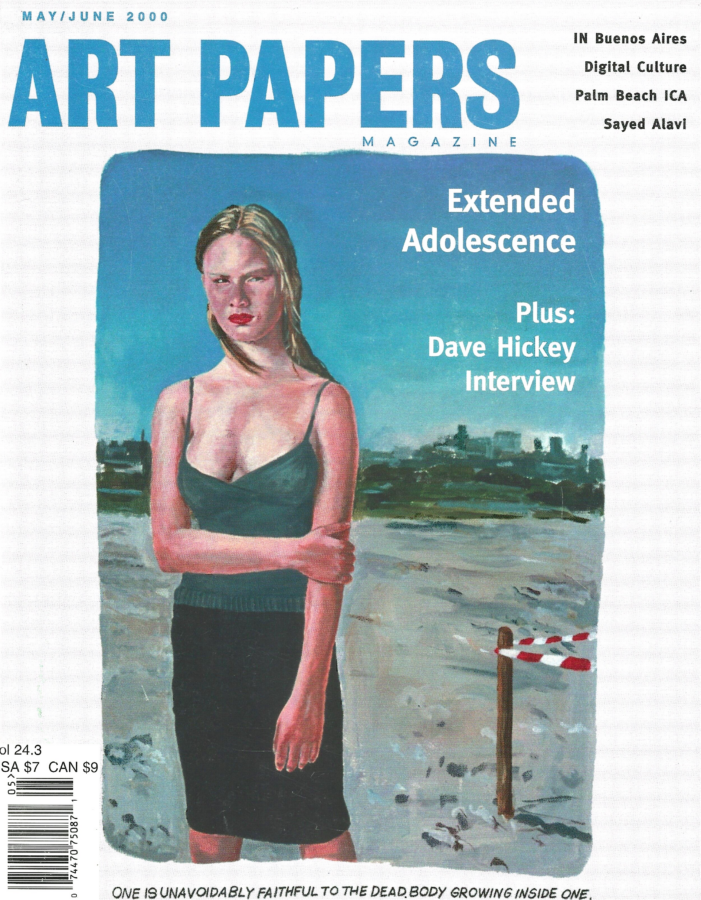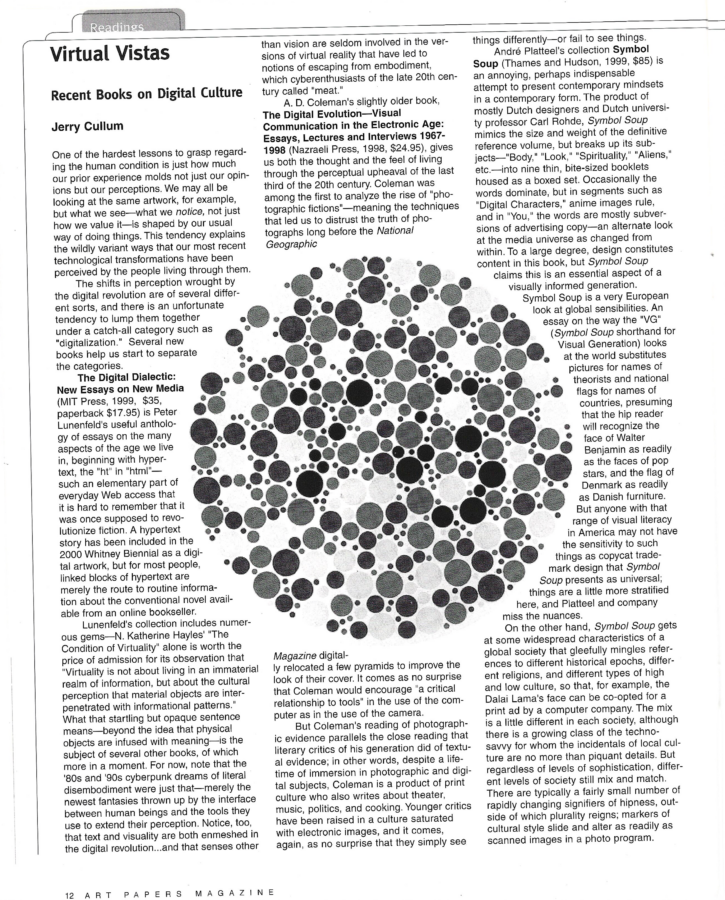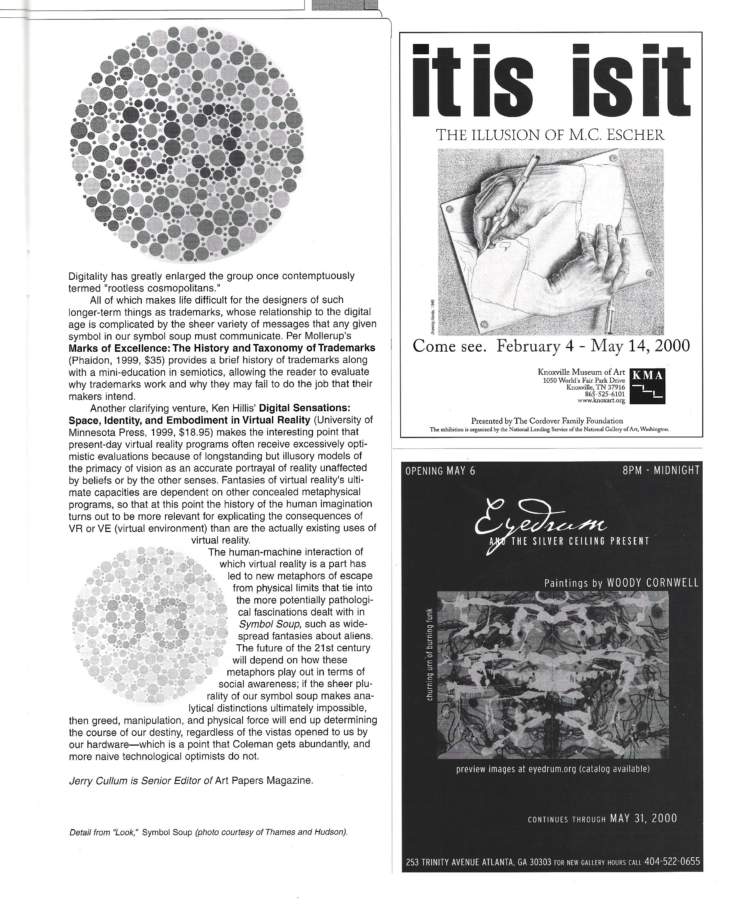Virtual Vistas
Detail from “Look,” Symbol Soup (photo courtesy of Thames and Hudson)
Share:
This article was originally published in ART PAPERS May/June 2000, Vol. 24, issue 3.
One of the hardest lessons to grasp regarding the human condition is just how much our prior experience molds not just our opinions but our perceptions. We may all be looking at the same artwork, for example, but what we see—what we notice, not just how we value it—is shaped by our usual way of doing things. This tendency explains the wildly variant ways that our most recent technological transformations have been perceived by the people living through them. The shifts in perception wrought by the digital revolution are of several different sorts, and there is an unfortunate tendency to lump them together under a catch-all category such as “digitalization.” Several new books help us start to separate the categories.
The Digital Dialectic: New Essays on New Media (MIT Press, 1999, $35, paperback $17.95) is Peter Lunenfeld’s useful anthology of essays on the many aspects of the age we live in, beginning with hypertext, the “ht” in “html”— such an elementary part of everyday Web access that it is hard to remember that it was once supposed to revolutionize fiction. A hypertext story has been included in the 2000 Whitney Biennial as a digital artwork, but for most people, linked blocks of hypertext are merely the route to routine information about the conventional novel available from an online bookseller.
Lunenfeld’s collection includes numerous gems N. Katherine Hayles’ “The Condition of Virtuality” alone is worth the price of admission for its observation that “Virtuality is not about living in an immaterial realm of information, but about the cultural perception that material objects are interpenetrated with informational patterns.” What that startling but opaque sentence means—beyond the idea that physical objects are infused with meaning—is the subject of several other books, of which more in a moment. For now, note that the ’80s and ’90s cyberpunk dreams of literal disembodiment were just that—merely the newest fantasies thrown up by the interface between human beings and the tools they use to extend their perception. Notice, too, that text and visuality are both enmeshed in the digital revolution…and that senses other than vision are seldom involved in the versions of virtual reality that have led to notions of escaping from embodiment, which cyber enthusiasts of the late 20th century called “meat.”
A. D. Coleman’s slightly older book, The Digital Evolution—Visual Communication in the Electronic Age: Essays, Lectures and Interviews 1967- 1998 (Nazraeli Press, 1998, $24.95), gives us both the thought and the feel of living through the perceptual upheaval of the last third of the 20th century. Coleman was among the first to analyze the rise of “photographic fictions”—meaning the techniques that led us to distrust the truth of photographs long before the National Geographic Magazine digitally relocated a few pyramids to improve the look of their cover. It comes as no surprise that Coleman would encourage “a critical relationship to tools” in the use of the computer as in the use of the camera.
But Coleman’s reading of photographic evidence parallels the close reading that literary critics of his generation did of textual evidence; in other words, despite a lifetime of immersion in photographic and digital subjects, Coleman is a product of print culture who also writes about theater, music, politics, and cooking. Younger critics have been raised in a culture saturated with electronic images, and it comes, again, as no surprise that they simply see things differently—or fail to see things.
André Platteel’s collection Symbol Soup (Thames and Hudson, 1999, $85) is an annoying, perhaps indispensable attempt to present contemporary mindsets in a contemporary form. The product of mostly Dutch designers and Dutch university professor Carl Rohde, Symbol Soup mimics the size and weight of the definitive reference volume, but breaks up its subjects—”Body,” “Look,” “Spirituality,” “Aliens,” etc.—into nine thin, bite-sized booklets housed as a boxed set. Occasionally the words dominate, but in segments such as “Digital Characters,” anime images rule, and in “You,” the words are mostly subversions of advertising copy—an alternate look at the media universe as changed from within. To a large degree, design constitutes content in this book, but Symbol Soup claims this is an essential aspect of a visually informed generation. Symbol Soup is a very European look at global sensibilities. An essay on the way the “VG” (Symbol Soup shorthand for Visual Generation) looks at the world substitutes pictures for names of theorists and national flags for names of countries, presuming that the hip reader will recognize the face of Walter Benjamin as readily as the faces of pop stars, and the flag of Denmark as readily as Danish furniture. But anyone with that range of visual literacy in America may not have the sensitivity to such things as copycat trademark design that Symbol Soup presents as universal; things are a little more stratified here, and Platteel and company miss the nuances.
On the other hand, Symbol Soup gets at some widespread characteristics of a global society that gleefully mingles references to different historical epochs, different religions, and different types of high and low culture, so that, for example, the Dalai Lama’s face can be co-opted for a print ad by a computer company. The mix is a little different in each society, although there is a growing class of the techno- savvy for whom the incidentals of local culture are no more than piquant details. But regardless of levels of sophistication, different levels of society still mix and match. There are typically a fairly small number of rapidly changing signifiers of hipness, outside of which plurality reigns; markers of cultural style slide and alter as readily as scanned images in a photo program. Digitality has greatly enlarged the group once contemptuously termed “rootless cosmopolitans.’
All of which makes life difficult for the designers of such longer-term things as trademarks, whose relationship to the digital age is complicated by the sheer variety of messages that any given symbol in our symbol soup must communicate. Per Mollerup’s Marks of Excellence: The History and Taxonomy of Trademarks (Phaidon, 1999, $35) provides a brief history of trademarks along with a mini-education in semiotics, allowing the reader to evaluate why trademarks work and why they may fail to do the job that their makers intend.
Another clarifying venture, Ken Hillis’ Digital Sensations: Space, Identity, and Embodiment in Virtual Reality (University of Minnesota Press, 1999, $18.95) makes the interesting point that present-day virtual reality programs often receive excessively optimistic evaluations because of longstanding but illusory models of the primacy of vision as an accurate portrayal of reality unaffected by beliefs or by the other senses. Fantasies of virtual reality’s ultimate capacities are dependent on other concealed metaphysical programs, so that at this point the history of the human imagination turns out to be more relevant for explicating the consequences of VR or VE (virtual environment) than are the actually existing uses of virtual reality.
The human-machine interaction of which virtual reality is a part has led to new metaphors of escape from physical limits that tie into the more potentially pathological fascinations dealt with in Symbol Soup, such as widespread fantasies about aliens. The future of the 21st century will depend on how these metaphors play out in terms of social awareness; if the sheer plurality of our symbol soup makes analytical distinctions ultimately impossible, then greed, manipulation, and physical force will end up determining the course of our destiny, regardless of the vistas opened to us by our hardware—which is a point that Coleman gets abundantly, and more naive technological optimists do not.
Jerry Cullum is a freelance curator and critic living in Atlanta, Georgia. His poems, reviews, and essays have appeared in a wide variety of local and national publications including Art Papers, where he served as Senior Editor for many years. He was an art critic for the Atlanta Journal-Constitution and an Atlanta contributor to ARTnews, Art in America, and other publications.


